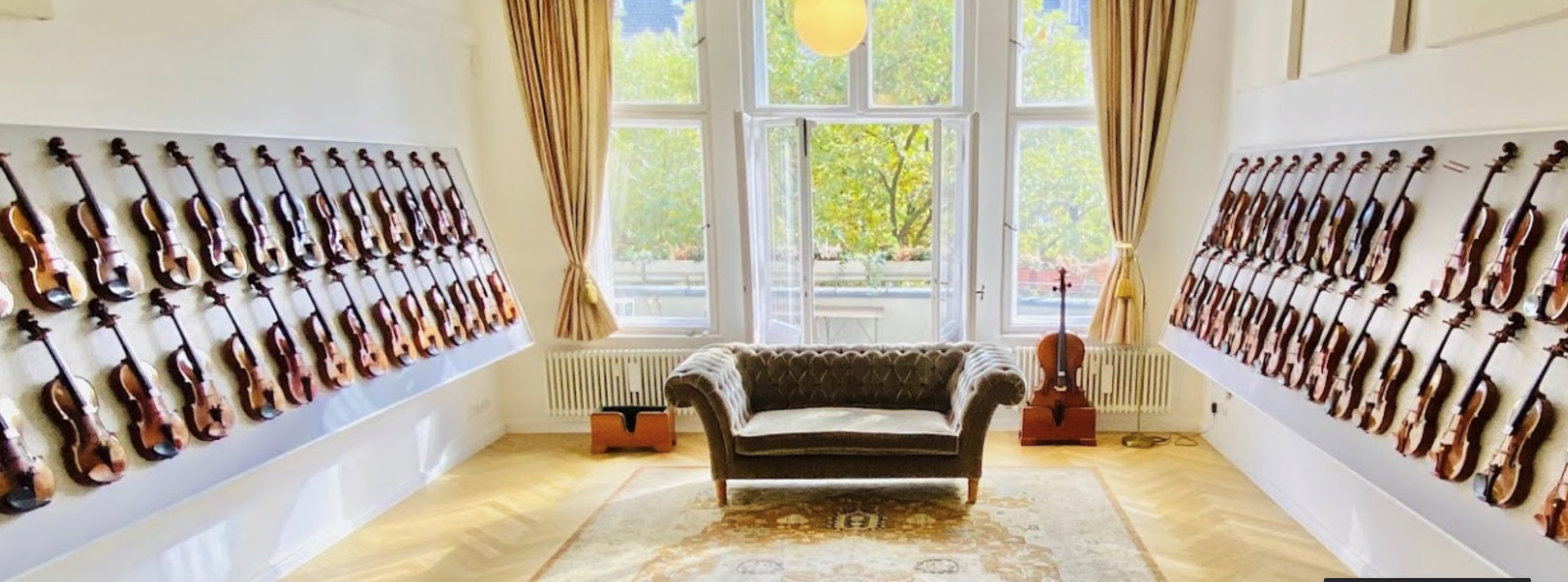Urban Gardner: Tarisio Fine Instruments & Bows Is a Testament to Timelessness
The Wall Street Journal, September 3, 2014
By Ralph Gardner Jr.The majesty of New York City is that you can stumble across amazing stuff, even when you’re just trying to find the men’s room.
That’s what happened a few weeks back when I visited Nola Rehearsal Studio on West 54th Street to watch a rehearsal of the Timeless Torches, Madison Square Garden’s middle-aged cheerleading squad.
On the way to the bathroom during a break, I passed a glass door and behind it a reception desk. But what caught my eye was an adjoining room, stacked floor to ceiling with cubbyholes. Each hole held a violin. And a young woman was standing in the middle of the room, playing one of the instruments.
Maybe it was because there was something unapologetically Everyman about the squad’s shameless booty-shaking performance, but the contrast between the festive atmosphere in their studio and this other space—it turned out to belong to Tarisio Fine Instruments & Bows, an auction house for violins, violas, cellos and bows—couldn’t have been more stark.
The tone of Tarisio trilled the tranquility of a scene by Vermeer—the amber light streaming through the windows and onto the violins looked as if it had been transported from 15th-century Holland.
While I should have gotten back to the Timeless Torches, I made my way through the glass door and met Jason Price, the company’s director.
“People see things here and play as long as they want,” Mr. Price explained. “They can bring their parent, teacher, stand partner, anyone. And they make their choice and go home and bid.”
“The auction houses—Christie’s and Sotheby’s—they all did violin sales,” but no longer do, Mr. Price said.
Tarisio, with offices in New York and London, holds 11 online auctions a year; the average price for a violin is in the $20,000-$30,000 range.
A row of bows for stringed instruments Andrew Lamberson for The Wall Street Journal
In 2012, though, Tarisio sold the “Primrose” Guarneri viola, made in 1697 by Andrea Guarneri in Cremona, Italy.
“There are six in the world,” Mr. Price said. “This is the best. It sold for $4.2 million. That’s the current record for a viola at auction.”
Had he ever handled a Stradivarius, I wondered?
In June 2011, Tarisio auctioned the “Lady Blunt” Stradivarius of 1721 for $15.9 million, a world record.
Indeed, Mr. Price had three Stradivariuses (or is it Stradivari?) in his walk-in vault.
“And one Guarneri del Gesu,” whose instruments rival those made by Stradivarius, he said as he led the way toward his inner sanctum. “Actually there are two Guarneri del Gesu.”
Mr. Price showed me one of the “Strads.”
“It comes from a private consignor in Europe,” he said. “A musician. He’s had it over 40 years.”
“We do lots of consignment trips,” he added. “We go to cities and go through orchestras, musicians unions; a pretty big network of players we’ve built up. A lot is word-of-mouth.”
I really had to get back to the Timeless Torches, who were undoubtedly breaking out new dance moves and working up a sweat. But I couldn’t pass up the invitation when Mr. Price offered to show me Antonio Stradivarius’s personal label.
He held the instrument under a light and there, inside it, was the delicate lettering.
“Antonio Stradivari made this in Cremona,” he said, translating.
Then, Mr. Price offered to show me Isaac Stern’s Louis Vuitton luggage.
“They came to us,” he said, of the violinist’s estate, which was sold in 2003 and included instruments, bows, musical ephemera, and even Mr. Stern’s humidor.
There was also a poster hanging in the vault that Mr. Stern had owned. It announced a London farewell concert by Paganini dated Aug. 17, 1832.
“Every spare inch had a picture of some musician,” Mr. Price remembered of Mr. Stern’s apartment at the Beresford.
Tarisio has a violin workshop on the premises, too. (Mr. Price handed me the disassembled front of a violin, made of spruce. It was light as a feather.) If I’d had more time I’d liked to have seen the workshop.
“It’s one of the things that made us distinctive,” he explained, adding that some of these instruments have been sitting in closets or safe-deposit boxes, gathering dust for decades. “Sotheby’s and Christie’s would sell as is. That’s fine for a restorer. But a musician can’t play that.
“It’s a really fun business,” he added “It’s been a real ride to take over the business from Sotheby’s and Christie’s; it’s too small for them. But if you concentrate on a niche business and do it right you can make a lasting business.”
I returned to the Timeless Torches and their rehearsal. But somehow my interest had waned.
Bright as they burned, they didn’t feel quite as timeless as a Stradivarius.


